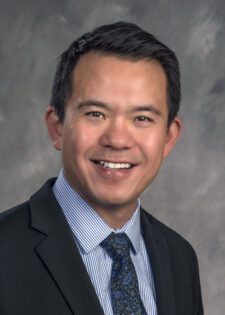
Dr. Weijen Chang
My last editor’s column focused on crisis leadership, specifically the example of Sir Ernest Shackleton’s doomed attempt to cross the Antarctic, which nonetheless proved to be a unique example of crisis leadership.1 But the acute urgency of the initial COVID-19 crisis has waned and morphed into a slog through the trenches of successive COVID-19 waves during a storm of health care provider vilification. Gone are the cheering crowds, raining down song and accolade upon us as we entered the arena to battle the dread COVID virus.2 In their place stand the vaccine deniers, conspiracy theorists, and mask revilers, belittling attempts of the Centers for Disease Control and Prevention (CDC) and state and local governments to walk the fine line between ignoring unforeseen consequences of pandemic controls and unleashing yet another wave of a variant virus.
In this acrimonious environment, how can we blame physicians, nurses, and other health care workers for leaving their professions in droves? Ingrained in our decision to choose a career in health care is the desire to work with our patients to improve their health, with our communities to optimize the social conditions, and with our local governments to build a framework that supports population health. But we’ve seen patients, even in our care, turn against us, communities turn against the very measures that would improve health, and local governments turn against the regulatory and legal framework designed to combat COVID-19. It’s no wonder about one in five health care workers have left their jobs since the pandemic began.3
As hospitalists and leaders, how can we stem the tide? We can start by rebuilding our work communities. Although there are exceptions, many hospitalists consider their groups and divisions to be a family of sorts. The pandemic drove many of us to be closer to our actual families and loved ones for good reasons, from lack of childcare and caring for ill loved ones, to renewed or newfound interests outside of work. All these are necessary and laudable reasons but engaging in a team effort toward a positive shared goal can reengage one in the joy of work.
According to Dr. Rebecca Newton, an organizational and social psychologist at the London School of Economics and faculty member of the Accelerated Leadership Program at Harvard Law School, “Joy is not just an individual phenomenon; it’s also what psychologists call ‘affiliative,’ which means that it has to do with strengthening our bonds with others through positive behaviors such as being kind and friendly or actively peace-making.”4
The Institute of Healthcare Improvement (IHI) agrees—finding joy, engagement, and productivity helps fight burnout that drives people out of health care careers. Jessica Perlo, MPH, a director at IHI, urges leaders to take a four-step approach to increase joy in work for their groups:5
- Ask staff, “What matters to you?” This requires asking the right questions, such as:
- What makes a good day for you?
- What makes you proud to work here?
- When we are at our best, what does that look like?
- Identify unique impediments to joy in work in the local context. This often occurs at the same time as Step 1.
- Commit to a systems approach to making joy in work a shared responsibility at all levels of the organization. Leaders at all levels have a role in this process, although not everyone does everything.
- Use improvement science to test approaches to improving joy in work. This requires measuring tests of change and having the time to devote effort to interventions and assessments of change.
The question posed in Step 1 is inexorably linked to whether people find meaning in their work, and this in turn is a deeply personal issue. Finding out what gives people meaning in their work can be challenging, requiring time regularly set aside specifically to ask this question, as the answer can evolve. It’s also possible that individuals on your team haven’t been able to clearly define what gives meaning to their work. As a result, you might need to mentor individuals to develop a “mission statement” for their careers.
As Patrick Conway said in a 2019 Journal of Hospital Medicine article, “So please, decide on your criteria and mission for career and life. When things are going well, review them. Are you still aligned with what is important to you? When you are at a crossroads to make a decision, review them again.”6
But as we often say as hospitalists, don’t ask questions you don’t want the answers to. Once you’ve asked what someone’s “mission statement” is for their career, as a leader, it’s your job to provide the tools and environment that allows them to succeed in achieving their goals. This doesn’t mean you need to mentor them personally throughout this process, but you should have a mentoring process in which they can participate. You also need to allow flexibility in their job, whether it’s through full-time equivalent (FTE) reduction or sharing FTE with other groups or divisions so they can achieve their goals. This might lead to temporary imbalances in your group’s staffing but keeping team members engaged in their career “mission” prevents group turnover.
Hospitalists are frequently their own worst enemy with Step 2. Drs. Andrew Dunn and Vinh-Tung Nguyen point out in their 2020 JHM article that well-meaning hospitalist-led quality improvement projects often produce excessive burden for an unknown benefit.7 This can add to the already growing burden of external tasks. Worse yet, hospitalist leaders are often driven by hospital or health-system leaders to set and achieve arbitrary relative value units (RVUs) or value goals, which can both waste precious team effort and undermine work towards true north goals.
As we enter this perfect winter storm of successive COVID-19 waves, resurgent non-COVID-19 illnesses, and staffing crises, remember that keeping your group intact depends on finding, on an individual level, reasons why each person finds joy at work. Make sure you continue to nurture and grow those reasons and pull out the weeds that would suck the joy from your team.
Dr. Chang, the physician editor of The Hospitalist, is a pediatric and adult hospitalist at Baystate Medical Center and Baystate Children’s Hospital in Springfield, Mass., where he is an associate professor of pediatrics at the University of Massachusetts Medical School Baystate, chief of pediatric hospital medicine, and vice-chair for clinical affairs at Baystate Children’s Hospital.
References
- Chang WW. Leading hospitalists during a pandemic. The Hospitalist. December 4, 2020. Available at: www.the-hospitalist.org/hospitalist/article/232875/leadership-training/leading-hospitalists-during-pandemic. Accessed November 30, 2021.
- Gamble M. Healthcare workers, once cheered as heroes, now threatened and harassed. Becker’s Hospital Review. September 2,2021. Available at: www.beckershospitalreview.com/workforce/healthcare-workers-once-cheered-as-heroes-now-threatened-and-harassed.html. Accessed November 30, 2021.
- Yong E. Why healthcare workers are quitting in droves. The Atlantic. November 16, 2021. (www.theatlantic.com/health/archive/2021/11/the-mass-exodus-of-americas-health-care-workers/620713)
- Newton R. Rediscover joy at work. Harvard Business Review. September 8, 2021. Available at: hbr.org/2021/09/rediscover-joy-at-work. Accessed November 30, 2021.
- Perlo J, et al. IHI Framework for Improving Joy in Work. IHI White Paper. Cambridge, Massachusetts: Institute for Healthcare Improvement; 2017. Available at ihi.org/resources/Pages/IHIWhitePapers/Framework-Improving-Joy-in-Work.aspx. Accessed November 30, 2021.
- Conway PH. Mission-Driven criteria for life and career. J Hosp Med. 2019;14(8):496.
- Dunn AS and Nguyen VT. Leadership & professional development: harness hassles to maximize meaning. J Hosp Med. 2020;15(12):739.


